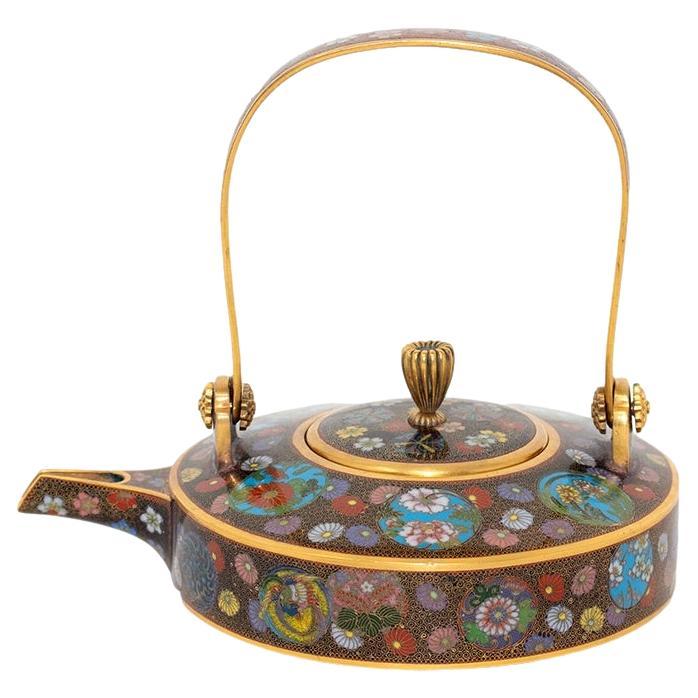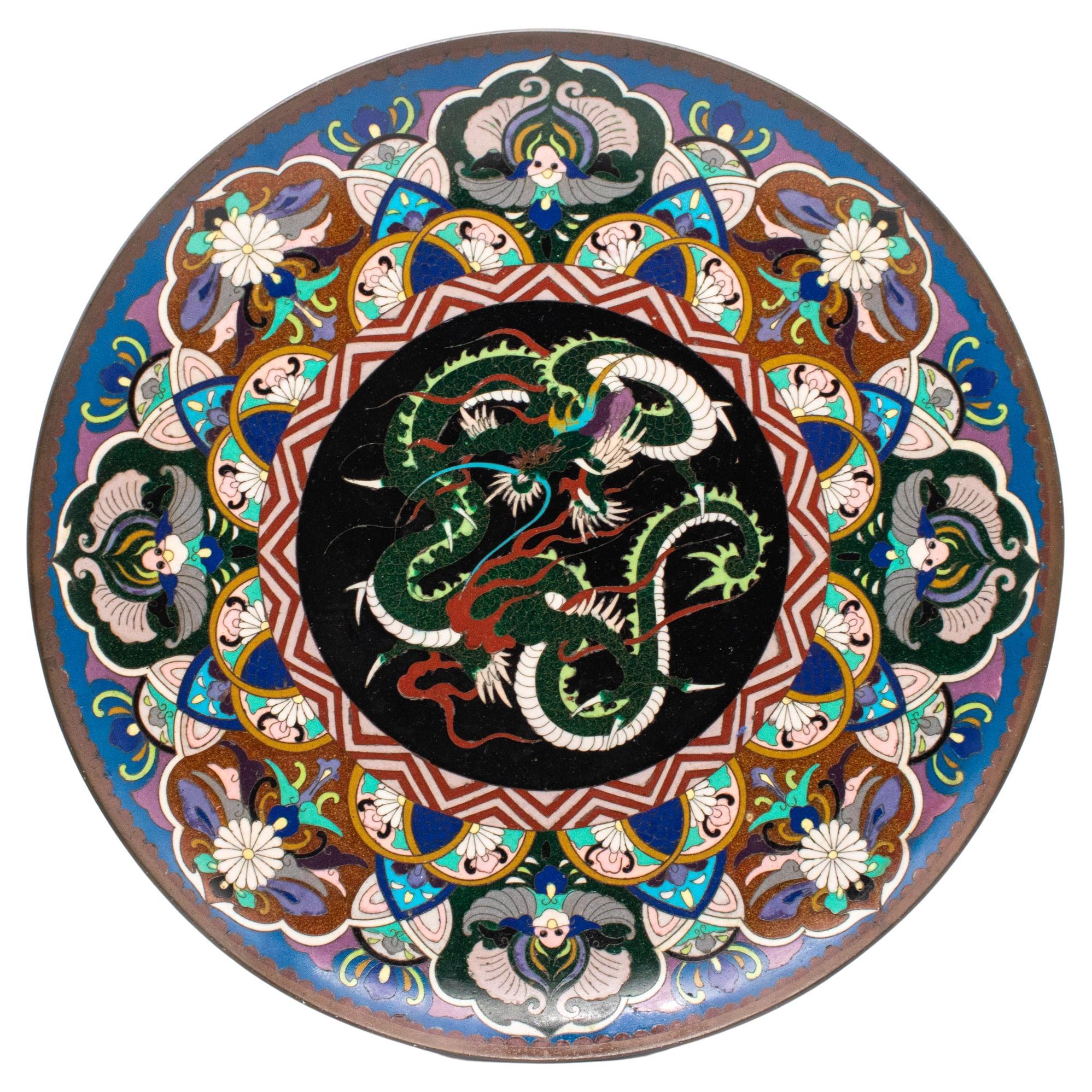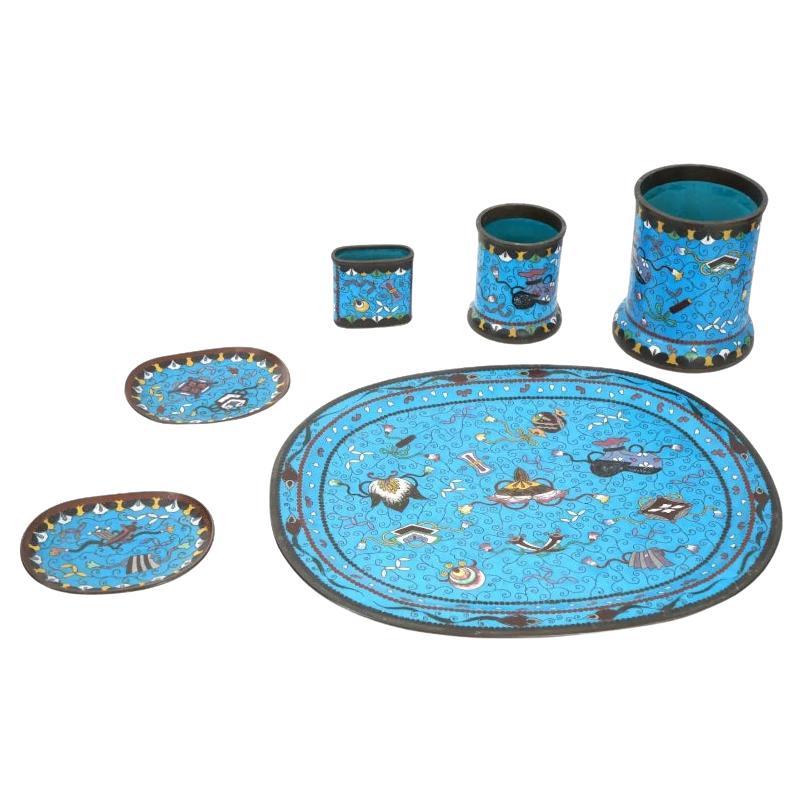Items Similar to Japan 1890 Meiji Period Decorative Vase In Cloisonné Enamel With Wood Base
Want more images or videos?
Request additional images or videos from the seller
1 of 7
Japan 1890 Meiji Period Decorative Vase In Cloisonné Enamel With Wood Base
About the Item
Japanese vase from the Meiji Period (1868-1912).
Beautiful antique decorative vase, created in Japan during the Meiji period (1868-1912), circa 1890s. It was carefully crafted in solid bronze with copper wires and embellished with applications of polychromatic cloisonné enamel with aventurine and gold flakes, depicting organics and natural motifs such a phoenix bird, a mythic dragon and flowers.
Weight: 240.95 Grams, (0.53 Pounds).
Measurements: Diameter of 89 mm, height of 114 mm (3.5 x 4.5 Inches).
The Meiji Period
This era of Japanese history that extended from October 23, 1868 to July 30, 1912.The Meiji era was the first half of the Empire of Japan, when the Japanese people moved from being an isolated feudal society at risk of colonization by Western powers to the new paradigm of a modern, industrialized nation state and emergent great power, influenced by Western scientific, technological, philosophical, political, legal, and aesthetic ideas. As a result of such wholesale adoption of radically different ideas, the changes to Japan were profound, and affected its social structure, internal politics, economy, military, and foreign relations. The period corresponded to the reign of Emperor Meiji. It was preceded by the Keiō era and was succeeded by the Taishō era, upon the accession of Emperor Taishō.
Cloisonné
This is an enameling technique in which the pattern is formed by wires soldered to the surface of the object to be decorated, which is usually made from copper, forming cells or cloisons, each of which holds a single colour of enamel paste which is then fired, and ground and polished. The champlevé technique also uses an enameling technique, but the cells are formed by carving into the surface ot the object, or in the casting. The cloisonné technique has been in use since the 12th century BC in the west, but the technique did not reach China until the 13th or 14th century. It became popular in China in the 18th century. Initially bronze or brass bodies were used, and in the 19th century copper, at which time the quality of th eitems produced began to decline. Chinese cloisonné is the best known enamel cloisonné, though the Japanese produced large quantities from the mid-19th century, of very high technical quality. In the west the cloisonné technique was revived in the mid 19th century following imports from China, and its use continued in the Art Nouveau and Art Deco periods.
Phoenix
This mythical bird-like creature combines elements of several different animals, birds and fish. It is said to appear only at times of enlightened rule, making it a symbol of peace and stability. Is also a symbol of good fortune and divine wisdom, the phoenix is believed to appear only in times of peace and prosperity bringing with it a message of hope and rebirth. In Japanese culture it also represents the goddess Amaterasu. A sun deity whose presence evokes the vital energy of the sun itself.
Collateral: It is accompanied by a carved wood base from the period.
Condition: The overall condition of this vase is excellent. Beside the little normal wear, there is no damage to the enamel. All parts are secured in the settings. This vase has been carefully inspected to guarantee the condition and authenticity.
INVENTORY REF: D030824XMNN/.5623
- Dimensions:Height: 4.5 in (11.43 cm)Diameter: 3.5 in (8.89 cm)
- Sold As:Set of 2
- Style:Meiji (Of the Period)
- Materials and Techniques:
- Place of Origin:
- Period:
- Date of Manufacture:1890
- Condition:Wear consistent with age and use. The overall condition of this vase is excellent. Beside the little normal wear, there is no damage to the enamel. All parts are secured in the settings. This vase has been carefully inspected to guarantee the condition and authenticity.
- Seller Location:Miami, FL
- Reference Number:
About the Seller
5.0
Platinum Seller
These expertly vetted sellers are 1stDibs' most experienced sellers and are rated highest by our customers.
1stDibs seller since 2023
63 sales on 1stDibs
Typical response time: <1 hour
- ShippingRetrieving quote...Ships From: Miami, FL
- Return PolicyA return for this item may be initiated within 1 day of delivery.
More From This SellerView All
- Japan 1890 Meiji Period Bronze Koro Censer in Cloisonne Enamel with Jade LidLocated in Miami, FLJapanese Koro from the Meiji Period (1868-1912). Beautiful antique ten sides fluted koro censer, created in Japan during the Meiji period (1868-1912), ci...Category
Antique 1890s Japanese Meiji Metalwork
MaterialsJade, Gold, Silver, Bronze, Enamel
- Japan 1900 Meiji Period Charger With A Dragon In Cloisonné Multicolor EnamelLocated in Miami, FLLarge charger in cloisonné from imperial Japan. Beautiful piece of Japanese decorative arts, created during the Meiji imperial period, circa ...Category
Antique Early 1900s Japanese Meiji Metalwork
MaterialsBronze, Copper, Enamel
- Ota Jinnoei 1890 Imperial Meiji Period Pair of Cloisonne Cabinet VasesBy Ota JinnoeiLocated in Miami, FLPair of cloisonne vases designed by Ota Jinnoei. Beautiful pair of small cabinet vases, created in Japan circa 1890, during the meiji Imperial period (1868-1912). These vases has ...Category
Antique 1890s Japanese Meiji Metalwork
MaterialsSilver, Bronze, Enamel
- Japan Meiji 1900 Three Bronze Ducks Sculpture in Wood Stand and CoralLocated in Miami, FLSculptural composition of the ducks from the Japanese Meiji Period. Beautiful and very well realized sculptural composition of three ducks, made during the japanese imperial perio...Category
Antique Early 1900s Japanese Meiji Sculptures and Carvings
MaterialsCoral, Bronze
- Japan 1890 Meiji Period Ebisu Sculpture in Wood Carving of an Old FishermanLocated in Miami, FLAn extremely well detailed wood carving of Ebisu, as a fisherman. Beautiful and well detailed sculpture, created in Japan during the Meiji dynastic period (1868-1912) back in the 1890's. This piece represent the god of good fortune Ebisu. Was exceptionally carved and executed from one solid single piece of rose wood, showing a gorgeous face expression, with intricate details in the hands and feets, he's carrying as usual a rod and a fish. Ebisu (yebisu), ???, god of fortune, the ocean and fisherman. In the japanese mythology is one of the seven gods of luck, sichi-fuku-jin, the patron of the fisherman and tradesmen. he is depicted as a bearded, smiling fisherman with formal long court ropes, often carrying a rod in one hand and a tai, symbolic fish of the good luck, in the other. The height is 14.25 inches (36.20 cm) and the base measurements is 6.5 by 6.45 inches (16.5 x 16.38 cm). Meiji period, is an era of Japanese history that extended from October 23, 1868 to July 30, 1912.The Meiji era was the first half of the Empire of Japan, when the Japanese people moved from being an isolated feudal society at risk of colonization by Western powers to the new paradigm of a modern, industrialized nation state and emergent great power, influenced by Western scientific, technological, philosophical, political, legal, and aesthetic ideas. As a result of such wholesale adoption of radically different ideas, the changes to Japan were profound, and affected its social structure, internal politics, economy, military, and foreign...Category
Antique 1890s Japanese Meiji Sculptures and Carvings
MaterialsWood
- Japan 1890 Meiji Period Signed Assembling of Okimono with a Group of SkeletonsLocated in Miami, FLA signed Okimono from the Japanese Meiji period (1868-1912). Very rare, unusual and large sculptural assembling of a dysplaying piece of okimono. Created in Japan during the imperial period of the Meiji (1868-1912). This extraordinary piece okimono sculpture depict a group of four intricately and realistically rendered carousing males skeletons representations (Gaikotsu) standing in several position. One skeleton is crouched down playing with mouses in the floor. The second is seated resting in the other's back, peacefully smoking opium. The others two are fully standing in interacting position. The entire composition is arranged freely displayed on the wood base including a woven basket, apparently with food and four playfull mouses. There are an extra five mouses in different positions, freely playing around, all of them with the eyes accented with carved black ebony. The composition is displayed on a four-legged free form carved wood platform with an inlaid red plaque engraved with the artist's signature. The level of detail and the quality of the carving is truly exceptional. Has an exact measurements of 216.15 mm by 139.7 mm by 359.41 mm (8.51 x 5.5 x 14.15 Inches). After an extensive collection of data, comparables and references to this piece, we have only been able to find only three okimono sculptures like this, with similar themes and the same quality of work. References Note: A similar carving of four skeletons playing an animated game of dominos, signed Shutaro in an inlaid rectangular red plaque, was sold in London by Christie’s South Kensington in October 14 2014, Lot 120 Sale 5546. References Note: A similar carving with four skeletons in an otherwise typical victorian scene of a photographer and three sitters signed Shutaro in an inlaid rectangular red plaque, was sold in Edinburgh at Lyon & Turnbull in November 7, 2018. References Note: A similar carving with five skeletons seated, playing cards and drinking, was sold in London by John Nicholson Fine Art on September 26, 2018. Meiji period, is an era of Japanese history that extended from October 23, 1868 to July 30, 1912.The Meiji era was the first half of the Empire of Japan, when the Japanese people moved from being an isolated feudal society at risk of colonization by Western powers to the new paradigm of a modern, industrialized nation state and emergent great power, influenced by Western scientific, technological, philosophical, political, legal, and aesthetic ideas. As a result of such wholesale adoption of radically different ideas, the changes to Japan were profound, and affected its social structure, internal politics, economy, military, and foreign relations. The period corresponded to the reign of Emperor Meiji. It was preceded by the Keio era and was succeeded by the Taisho era, upon the accession of Emperor Taisho. Okimono, is a Japanese term meaning for display an ornament; art object; or decorative object, usually displayed in a tokonoma or butsudan "Buddhist altar". It is an ornament or figure, especially one placed in a guest room. An okimono may be a small Japanese carving...Category
Antique 1890s Japanese Meiji Sculptures and Carvings
MaterialsWood
You May Also Like
- Japanese Cloisonne Enamel Vase Pair Meiji PeriodLocated in Newark, EnglandA sensational pair of Japanese Meiji period Cloisonne enamel bottle vases. The vases of slender hexagonal form with trumpet opening upon a circular foot. Decorated to the highest qua...Category
Antique Late 19th Century Japanese Meiji Metalwork
MaterialsMetal, Silver
- Large Japanese Cloisonné Enamel Dish, Japan Meiji periodLocated in Saverne, Grand EstBronze and cloisonné enamel dish very finely decorated with an egret in flight above various flowers on a background of copper inclusions and gold powder. The wing decorated in parti...Category
Antique Late 19th Century Japanese Meiji Metalwork
MaterialsBronze
- Japanese Meiji Period Cloisonne Enamel Sake PotLocated in Newark, EnglandFine Japanese Meiji period cloisonne enamel Sake pot. The Sake pot of rounded form with with clean edges profusely decorated with blossoming flowers throughout upon a black ground ba...Category
Antique Late 19th Century Japanese Meiji Metalwork
MaterialsMetal, Enamel
- Japanese Cloisonne Enamel Meiji Period 6 Pcs Writing SetLocated in New York, NYA Japanese Meiji period cloisonne enamel writing set comprising 6 pieces decorated in the same style with floral patterns, including an oval tray, two plates and three cups of variou...Category
Antique Late 19th Century Japanese Meiji Metalwork
MaterialsEnamel
- Japanese Meiji Period Cloisonne BowlLocated in Hamilton, OntarioJapanese Meiji period cloisonne bowl.Category
Antique 19th Century Japanese Meiji Metalwork
- Large Pair of Meiji Period Japanese Cloisonne Enamel Double Dragon VasesLocated in New York, NYA large pair of Meiji Period Japanese Cloisonne Enamel Double Dragon Vases, 19th century. Japanese cloisonne enamel dragon vases are highly ...Category
Antique 19th Century Japanese Meiji Metalwork
MaterialsCopper, Enamel
Recently Viewed
View AllMore Ways To Browse
Buffet Set Of Two
Mid Century Chair With Sheepskin
Matching Side Chests
Table Lamp Square Set
Glass And Metal Side Tables Pair
Paintings Of Bavaria
Wood Campaign Chest
Floor Lamp0
Midcentury Trolley Teak
Pairs Of Lamps With Birds
Solid Cherrywood Furniture
Giorgetti Italian
Louis Round Mirror
Henning Kjaernulf Oak Chairs
Deco Green Glass Lamp
Melrose Antiques
Modular Sofa Down
Swedish Chandelier 1930





